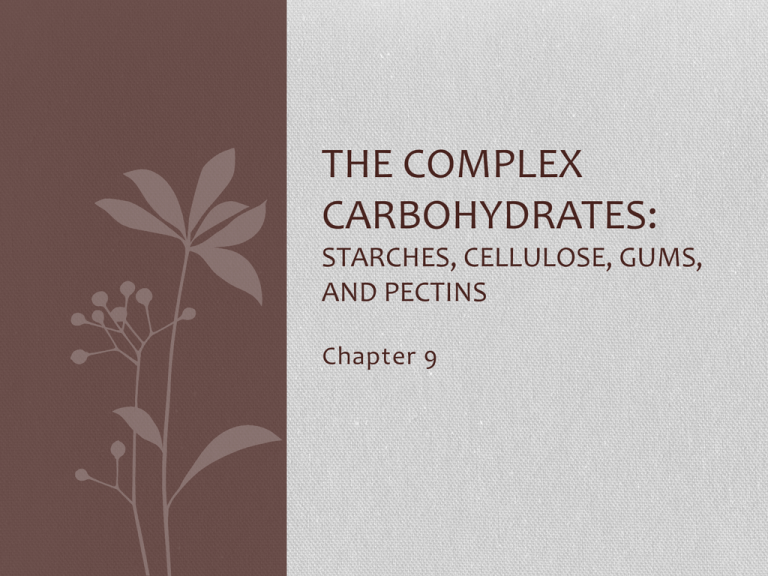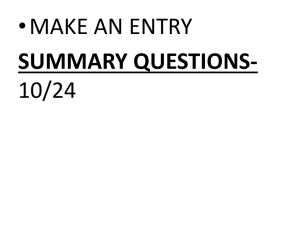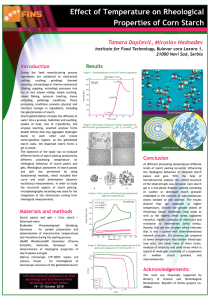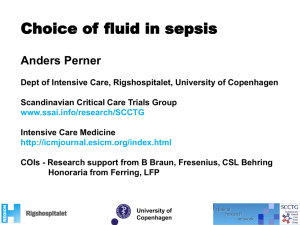The Complex carbohydrates: Starches, cellulose, gums, and pectins
advertisement

THE COMPLEX CARBOHYDRATES: STARCHES, CELLULOSE, GUMS, AND PECTINS Chapter 9 Complex Carbohydrates in the Diet Complex carbs are found in wide variety of grains and grain-based products • Breads • Cereals • Muffins • Cakes • Cookies • Pastas • Rice Types of Complex Carbohydrates Starches Cellulose Gums Pectins Starches • Most abundant complex carbohydrate in the diet is starch. • Made of 100 to several thousand glucose units linked in chains • Polymer: large molecule that consists of large numbers of small molecular units linked together. Starches • Sources: • Main source is wheat flour • Rice • Corn • Potatoes • Oats • Rye • Sorghum • Soy • Tapioca • Arrowroot Starches Have two basic structures: Linear (amylose) Branched (amylopectin) Starches • Granules: packets of starch produced by plants, not soluble in cold water. • Size and shape vary from plant to plant. • Rice has the smallest granules • Potatoes have the largest granules • Starch granules are a mixture of amylose and amylopectin molecules • Varying ratios cause each type of starch to act differently in food mixtures. • Starches composed of mainly amylopectin are called waxy starches. Cellulose • Polysaccharide made from large amounts of beta-D-glucose. • Humans lack the digestive enzymes needed to break the bonds in cellulose molecules. • Known as fiber • Forms rigid structure in plants • Strings in celery • Membranes surrounding kernels of corn Carbohydrate Gums and Pectins Carbohydrate Gums Pectins • Polysaccharides that are soluble in water and extracted from plants. • Thicken and stabilize mixtures • Traps color and flavor • Provide stability and texture for foods such as salad dressings and gummy candies. • Used as food additives (handout) • Complex carb found in plan cells and made of chemical derivatives of sugar called sugar acids. • Naturally occurs in fruit • Produce a strong gel • In presence of sugar, pectin molecules will dehydrate • Acid will create a thickened structure • Jams and jellies. Functions of Complex Carbohydrates in food Preparation PROVIDE STRUCTURE BIND THICKEN WHAT ARE SOME STARCH BASED FOODS THAT RELATE TO EACH OF THE ABOVE FUNCTIONS? Provide Structure • Flour provides majority of structure of baked goods and many other food products. • Cereals retain their shape due to starch content • Starch thickens when heated and gels when cooled • Cellulose forms the framework for fruits and vegetables • Pectins and gums responsible for the texture of jams, jellies, ice cream products, and gummy textured candies. Bind Binding agents are substances that tend to hold two other products together. Amylose molecules will work better than amylopectin at holding batters to vegetables and meats during deep frying. Carageenan is a gum used as a binding agent. Guar and xanthan gums are used to improve the consistency of gluten free baked goods. The starch in flour binds the batter to onion rings so it does not separate from onions during frying. Thicken • Starch • Thicken liquids • Molecules of arch are chemically altered as they swell and take up water • When heated, starch molecules relax and hydrogen bonds form between starch molecules and water. • Gelatinization occurs which means to thicken a liquid with starch. • The temp. at which maximum swelling occurs in the gelatinization point. • Too much heat can cause starch to loose thickening ability. • Starch molecules are much larger than water molecules, and are like tumbleweeds Thicken • Pectin • Used to thicken jams and jellies Liquid and powdered pectin are available for thickening homemade jams and jellies. Commercially, pectin is used as a thickener and stabilizer in such foods as ice cream and candy Types of starch and liquid mixtures • Sols- thickened liquids • Pancake and waffle mix, white sauce and gravy • Pastes- thickened mixtures of starch and liquid that have very little flow. • Gravy (starch combined with water or milk) • Gels- a rigid starch mixture • Pudding • Jell-O • Slurries- uncooked mixtures of water and starch PHYSICAL PROPERTIES OF STARCH AND LIQUID MIXTURES Retrogradation Viscosity Stability Opacity versus Translucency Texture Retrogradation • Firming of a gel during cooling and standing • Occurs because starch granules are trying to return to the structure they had before cooking. • Desirable when it causes a gel to thicken during cooling • Undesirable if it continues to the point that cracks form in the gel. • Syneresis is the term used for water leaking from gel over time • Ex. liquid that separates from mustard • Acids break down starches and gels which reduces the thickening of starch. Viscosity •The resistance of a mixture to flow •Measured by line spread sheets (see handout) •The more solid that is present the more viscosity there will be. • http://www.youtube.com/watch?v=3KU_skfdZVQ Stability • Ability of a thickened mixture to remain constant over time and temperature changes. • A stable sauce can be frozen and reheated with no change in in appearance or taste. • Waxy maize starch is a clear, soft paste that is as thick hot as cold. • Cornstarch is not stable in prolonged heat • Would be better to use flour in a gravy mixture because it would stay smooth over time. Opacity vs. Translucency • Opacity: how much an object blocks light • Gels made with wheat starch • Translucency: how much light can pass through an object • Gels made with cornstarch, potato starch, and arrowroot. Texture •Ex. You can use cornmeal to thicken gravy but most people would not like it because it would feel gritty and not smooth. •Ex. Whole wheat flour would also be gritty Modified Starches • Starches that have been changed structurally by chemical or mechanical means. • Most common sources of modified starches: • Wheat • Corn • Soy • Can modify • Viscosity • Mouthfeel • Appearance • Cross-linked starch: Changed chemically so cross-bonding or crosslinking takes place between starch molecules. • Many frozen entree's and instant, quick-mix foods would not be possible without these starches THICKENING SAUCES WITH STARCH Cold water paste Starch and fat Starch and sugar Corn starch and water • http://www.youtube.com/watch?v=amfjWWMg9c0 Cold Water Paste •Method for preventing lumps when thickening •Quickly stir starch while adding an equal amount of cold water. •Once smooth, more water can be added and and put on heat t begin the thickening process. •Can be used for soup stock or gravy. Starch and Fat • Separate starch granules with melted fat. • Add equal amount of starch to hot melted fat and stir. • Then the liquid can be added slowly. • Constant stirring • Used to make white sauce and gravy from meat drippings. Starch and Sugar •Combine starch and sugar •Gradually add liquid •Constant stirring •Sugar helps separate the starch granules and keeps them from sticking. NUTRITIONAL IMPACT OF COMPLEX CARBOHYDRATES Like sugar, digestible starches provide 4 kilocalories of energy per gram. Starch is the most economical and abundant source of calories available to people. Fiber, Bran, and Bulk • Cellulose (fiber) provides bulk in the diet. • Helps make you feel full • Aids in digestion and elimination of waste. • Indigestible • Sources • Fruits • Vegetables • Grains Nutritional Functions of Carbohydrates • Main function of carbohydrates: • Provide energy for bodily functions • Other functions: • • • • Provide bulk for the digestive process Tie up bile acids, decreasing their reabsorption Lower cholesterol levels in blood Promote the utilization of fat • Should not be routinely consumed over the recommended daily amount.





